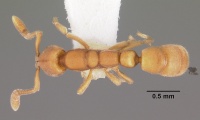Iroponera odax
| Iroponera odax | |
|---|---|

| |
| Scientific classification | |
| Kingdom: | Animalia |
| Phylum: | Arthropoda |
| Class: | Insecta |
| Order: | Hymenoptera |
| Family: | Formicidae |
| Subfamily: | Ponerinae |
| Tribe: | Ponerini |
| Genus: | Iroponera |
| Species: | I. odax |
| Binomial name | |
| Iroponera odax Schmidt & Shattuck, 2014 | |
The only member of this monotypic genus, Iroponera odax is known from south-eastern Australia. This ant has been encountered only a handful of times and very little is known regarding its biology. All collections have been made at wetter sites consisting of wet sclerophyll woodlands. Nests occur in soil under rocks or under bark and contain only a few workers. The lack of eyes, small body size and pale color suggest a hypogeic lifestyle, and this may explain their infrequent collection. (Schmidt and Shattuck 2014)
Identification
Schmidt and Shattuck (2014) - Iroponera workers (odax is the only species in this genus) are recognizable by the presence of a single metabial spur, absence of eye (although small dimples or slight discolorations are sometimes present where the eyes would be expected) and elongate and narrow mandibles with three or four small, widely spaced teeth. In overall body shape and size Iroponera closely resembles Hypoponera or Ponera, and all of these genera share the single metatibial spur. However, the unique mandibular shape and lack of eyes will separate this genus from others in the subfamily.
Distribution
Distribution based on Regional Taxon Lists
Australasian Region: Australia (type locality).
Distribution based on AntMaps
Distribution based on AntWeb specimens
Check data from AntWeb
Countries Occupied
| Number of countries occupied by this species based on AntWiki Regional Taxon Lists. In general, fewer countries occupied indicates a narrower range, while more countries indicates a more widespread species. |

|
Estimated Abundance
| Relative abundance based on number of AntMaps records per species (this species within the purple bar). Fewer records (to the left) indicates a less abundant/encountered species while more records (to the right) indicates more abundant/encountered species. |

|
Biology
Castes
Known only from the worker caste.
Images from AntWeb
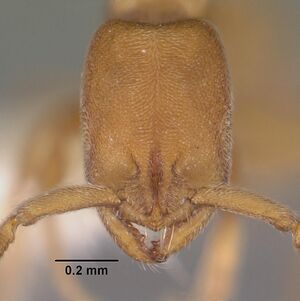 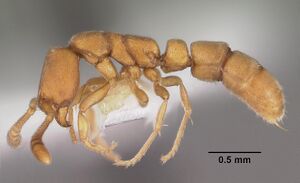 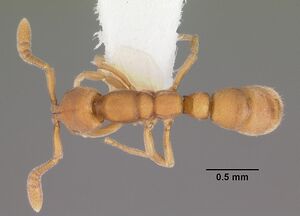 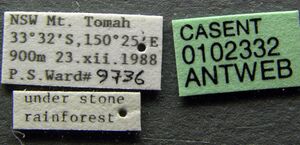
| |
| Worker. Specimen code casent0102332. Photographer April Nobile, uploaded by California Academy of Sciences. | Owned by NHMUK, London, UK. |
Nomenclature
The following information is derived from Barry Bolton's Online Catalogue of the Ants of the World.
- odax. Iroponera odax Schmidt, C.A. & Shattuck, 2014: 198, fig. 46 (w.) AUSTRALIA (Tasmania, New South Wales, Victoria).
- Type-material: holotype worker, 5 paratype workers.
- Type-locality: Australia: Tasmania, Pioneer State Forest, approx. 41°05’S, 147°56’E, 14.i.1992, sassafras gulley, in soil bank (B.B. Lowery & L. Gregson).
- Type-depository: ANIC.
- Distribution: Australia.
Unless otherwise noted the text for the remainder of this section is reported from the publication that includes the original description.
Description
Worker
(see also genus description): Head oblong, with nearly straight, parallel sides; posterior corners rather abruptly rounded; vertexal margin very shallowly concave. Frontal lobes broad, together occupying a space greater than 1/3 HW, roofing antennal insertions and nearly all of antennal radicles. Scapes gradually incrassate apicad; funiculus with massive 4-segmented apical club, significantly wider than scape, and at least twice as wide as basal funicular segments. Labrum shallowly bilobed, the lobes broadly rounded. Palpal segment count not determined, but apparently 2,2 or less.
Mesosoma slender, tapering only moderately caudad, with only a weak and brief constriction at the mesonotal groove. Petiole with steeply sloping anterior face; dorsal face distinct, but rounding into posterior face; in dorsal view slightly broader than long, even including the brief anterior cornuae. Subpetiolar process a broad blade with convex margin. Gaster cylindrical, straight, with a distinct constriction after A3; A4 broader than A3, and the same length, not vaulted. A5 as wide as A4, but slightly longer; terminal segments conical and retractile; sting strong.
Sculpture exceedingly fine, densely micropunctulate; opaque, with only A5, gastric apex, propodeal declivity, posterior face of petiolar node and limited parts of the appendages showing a weak shine. Pilosity scattered and with moderately dense pubescence. Color dull, light yellow throughout.
Measurements (holotype): total length 2.5mm, head length 0.62mm, head width 0.44mm (cephalic index 71), mandible length 0.27mm, scape length 0.30mm (scape index 68), Weber’s length 0.80mm, petiole length 0.27mm, hind femur length 0.35mm, hind tibia length 0.31mm.
Type Material
Type material: Holotype worker and five paratype workers from Pioneer State Forest, Tasmania, Australia, approx. 41°05'S 147°56'E, 14 January 1992, B.B. Lowery & L. Gregson, sassafras gully, in soil bank (Australian National Insect Collection, holotype ANIC32-066627, paratypes ANIC32-002572).
References
- Esteves, F.A., Fisher, B.L. 2021. Corrieopone nouragues gen. nov., sp. nov., a new Ponerinae from French Guiana (Hymenoptera, Formicidae). ZooKeys 1074, 83–173 (doi:10.3897/zookeys.1074.75551).
- Schmidt, C.A. & Shattuck, S.O. 2014. The higher classification of the ant subfamily Ponerinae (Hymenoptera: Formicidae), with a review of ponerine ecology and behavior. Zootaxa 3817, 1–242 (doi:10.11646/zootaxa.3817.1.1).

